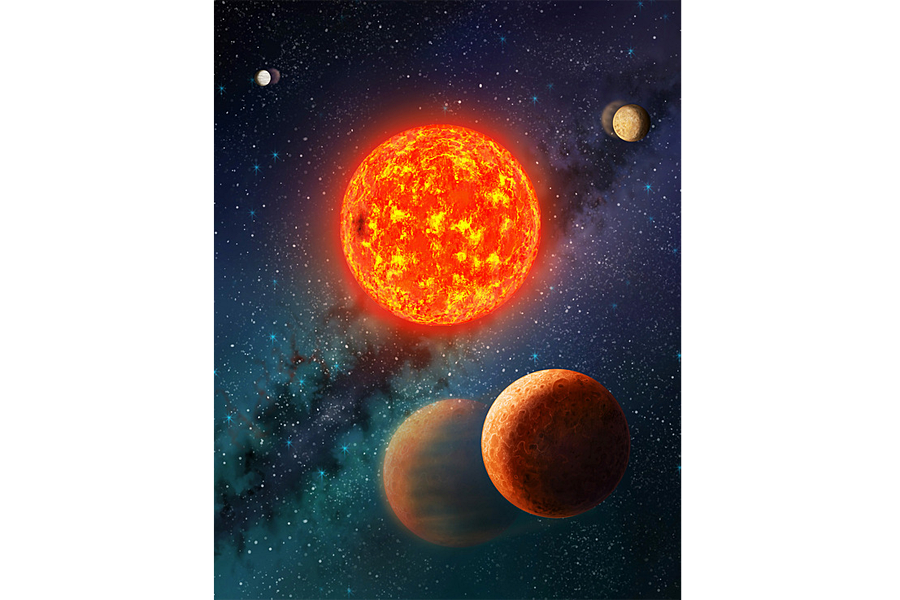Are we the only intelligent life in cosmos? Probably not, say astronomers.
Loading...
Astronomers revised the half-century old Drake equation, which attempts to calculate the probability of the existence of advanced alien civilizations, to determine whether any such civilizations have existed at any point in the history of the universe.
They found that the chances that a human civilization evolved on Earth and nowhere else in the universe are less than about one in 10 billion trillion.
“To me, this implies that other intelligent, technology-producing species very likely have evolved before us,” said Adam Frank, professor of physics and astronomy at the University of Rochester, in a statement. Dr. Frank was a co-author on a paper on the subject published in the journal Astrobiology on April 22.
To put it another way, as Chris Harwood points out on CBSNews.com, even if life evolves on only one planet in a billion that are orbiting in the habitable zones of their stars, meaning at the right distance to create the temperature needed for water to remain liquid, which is considered a prerequisite for life, "that still means it's happened on the order of 10 trillion times," said Dr. Frank to CBS.
To determine their probability, Dr. Frank and his co-author, University of Washington astronomer Woodruff Sullivan, decided that it was time to update the famous Drake equation – N = R* · fp · n · fl · fi · fc · L – which was developed in 1961 by astronomer Frank Drake to estimate the number of technological civilizations that may exist in our galaxy.
Here is a description of the Drake equation, according to SETI, or “Search for Extraterrestrial Intelligence,” Institute:
N = The number of civilizations in The Milky Way Galaxy whose electromagnetic emissions are detectable.
R* = The rate of formation of stars suitable for the development of intelligent life.
fp = The fraction of those stars with planetary systems.
ne = The number of planets, per solar system, with an environment suitable for life.
fl = The fraction of suitable planets on which life actually appears.
fi = The fraction of life bearing planets on which intelligent life emerges.
fc = The fraction of civilizations that develop a technology that releases detectable signs of their existence into space.
L = The length of time such civilizations release detectable signals into space.
When Dr. Drake developed his equation, there were gaps in knowledge, such as how many stars have planets that could potentially harbor life, how often life might evolve and lead to intelligent beings, and how long any civilizations might last before becoming extinct.
Some of these gaps have been resolved, thanks to NASA’s Kepler Telescope and other searches that have found loads of exoplanets, or planets orbiting stars other than our sun. Scientists now know that about one-fifth of stars have planets in habitable zones.
This still leaves a couple of questions, though. One is how long civilizations can survive (long enough to communicate with us?), which is really hard to answer. So Frank and Dr. Sullivan decided to pose a much broader question: Have other civilizations ever existed?
“This shifted focus eliminates the uncertainty of the civilization lifetime question and allows us to address what we call the ‘cosmic archaeological question’—how often in the history of the universe has life evolved to an advanced state?” said Sullivan in a statement.
Another unknown that remained was how likely advanced life is to evolve on habitable planets. Instead of guessing the odds of that, the astronomers decided to calculate its opposite: how low is the probability that humans make up the only civilization ever to exist in the universe? The answer they found for this is one in 10 billion trillion. In our own galaxy Milky Way, the number rises to one chance in 60 billion.
“We call that the pessimism line,” said Frank. “If the actual probability is greater than the pessimism line, then a technological species and civilization has likely happened before,” he said.
Frank and Sullivan’s new equation – A = Nast · fbt – draws on Drake's, but eliminates some of the uncertainties. In their equation “A” is “number of technological species that have ever formed over the history of the observable universe.” “Nast ” and “fbt ” are multiplied to get the result. “Nast ” refers to the “number of habitable planets in a given volume of the universe,” and “fbt ” is the “likelihood of a technological species arising on one of these planets.”
One in 10 billion trillion is a very low probability that humans are alone in the universe, say the researchers. But given the vast distances between stars, and the uncertainty of how long civilizations exist, means we may never be able to communicate with other civilizations.
Unless a typical civilization lasts much longer than the 10,000 years that we’ve been around, all of them are likely already extinct, given that the universe is considered to be more than 13 billion years old. Others likely won’t evolve until we are long gone, the astronomers say.
But despite this, there is a practical application to their result, the researchers said.
“Our results imply that our evolution has not been unique and has probably happened many times before,” Frank said. “The other cases are likely to include many energy-intensive civilizations dealing with their feedback onto their planets as their civilizations grow. That means we can begin exploring the problem using simulations to get a sense of what leads to long-lived civilizations and what doesn’t.”







